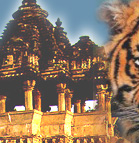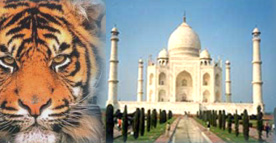|
The splendid rock cut caves of Ajanta and Ellora are located near Aurangabad, a city in Maharashtra, a state in western India. These temples represent the pinnacle of rock cut temple architecture in India achieved by the ancient craftsmen. The temples cover a vast range of Buddhist, Hindu, and Jain religious themes, and were built over a period of several centuries between the 2nd century BC, to about 9th century AD. Both the cave complexes have been declared as world heritage sites by the UNESCO. Together they are among the best known tourist attractions in India.
Ajanta Caves:
The Ajanta caves comprise a set of 30 caves that are lined in a horse shoe shape besides the Waghora river gorge. These caves were discovered accidentally by a British officer during a hunt.
The caves fall into two groups, the earlier ones dating back to the 2nd to 1st century BC. During this period, Hinayana Buddhism was dominant and Buddha was represented by various symbols and not in his human form. The second group dating between 5th to 6th centuries AD belongs to the Mahayana period and contains sculptures of Buddha in his human form.
The caves can be classified structurally into chaityas (prayer halls) and viharas (monastery). The caves are famous all over the world for their exquisite murals, painted ceilings, carved pillars, and the occasional large figures of Buddha in various postures. Notable among these is the cave 26, which showcases two magnificent panels, including a 7 meters long image of reclining Buddha, depicting Parinirvana (death of Gautama Buddha).
The murals are among the finest and most ancient paintings to be seen in India. They were executed between the 2nd century BC and 5th century AD, but still look as fresh as if they were painted a few days ago. The themes range from the Jataka tales that recount the story of Buddha in his various incarnations, to the everyday courtroom themes, and scenes from everyday life of the period. The colors are still very vibrant and are remarkably well preserved despite lying unattended for several centuries.
Ellora caves:
The 34 caves at Ellora are located 30 kilometers north west of Aurangabad. They are dated later than the Ajanta caves. Commissioned by the Chalukya and Rashtrakuta kings, they represent a Hindu renaissance in India that coincided with decline in Buddhism. The period covered is between 7th � 9th centuries AD.
The centerpiece of the Ellora caves is the Kailasanatha temple. A UNESCO world heritage site, this magnificent temple ahs been carved downwards out of a single cliff, an incredible achievement, considering the age of construction. Approximately 3 million cubic feet of rock were chiseled by the ancient artisans to create this ancient wonder of India. The temple (cave 16) is supposed to represent mount Kailasa, the holy abode of Lord Shiva. It was commissioned by the 8th century Rashtrakuta ruler, Krishna I. the interior of the temple is as impressive as the exterior and contains a large number of intricate sculptures depicting various Hindu mythological themes.
The complex also contains Buddhist (1 to 12) and Jain caves (30- 34) which include remarkable viharas and chaitya grihas meant for ritualistic as well as residential purposes.
The Ellora caves complex is also a protected place declared as a world heritage site by the UNESCO. Together with the Ajanta caves, they form the core of tourism in Maharashtra.
The Ajanta and Ellora caves can be easily reached by air; railway or the roadways, as a large number of transportation options are available.
Learn more about the Ajanta and Ellora caves and other ancient wonders of India in touristplacesinindia.com.
Back to Seven Wonders of India
 |
|

